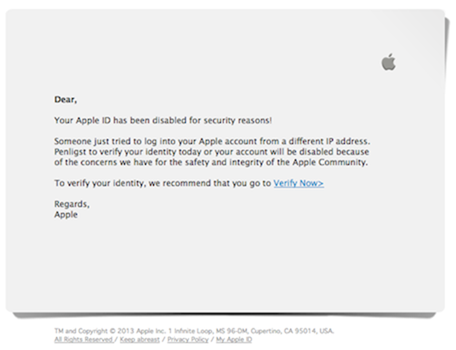When it comes to the online world, pretty much anything is possible, which is why we need to be extremely careful and vigilant when enjoying the spoils that the cyber world offers. Unfortunately not everyone is as ethical or as moral as we would hope, which is why we need to be on the lookout for Internet scams and those trying to take advantage. The latest malicious plan that Internet users need to be aware of is an Apple ID phishing attempt that looks deceptively realistic.
For those that may be new to the Internet, or choose to believe that the online world is a place of peace and tranquility, phishing is a way for morally bankrupt individuals to try and get access to sensitive data such as usernames, password and financial data by masquerading as an official entity. This latest scam does a fairly good job of mimicking an official Apple email and comes with the header “You Apple ID has been disabled for security reasons!”. Of course, a little additional information is provided to build up the appearance of authenticity before attempting to get the recipient to click on a malicious link that redirects to an untrusted destination.

The sole purpose of this phishing attempt is to gain access to the recipients Apple ID account. When the “Verify Now” link in the email is clicked it actually takes the individual to a malicious link, which should immediately cause some concerns considering the top-level domain extension belongs to Tokelau in the South Pacific.
We’re sure that Tokelau is a beautiful location but it isn’t exactly well-known for being the hub of Apple’s operations. Also, as TUAW rightly point out, the Tokelau top-level domain was also responsible for more than 20% of phishing scams in 2010.

If you ever receive this particular email, or one of a similar nature, it’s worth remembering that Apple will never request an account to be verified or a password to be reset by providing the Apple ID and current password. If in any doubt over the security or integrity of an Apple account then it’s always worth proactively visiting the Apple site yourself so that you know you are going to the right place.
Stay safe out there kids.
(via: TUAW)
You can follow us on Twitter, add us to your circle on Google+ or like our Facebook page to keep yourself updated on all the latest from Microsoft, Google, Apple and the web.

